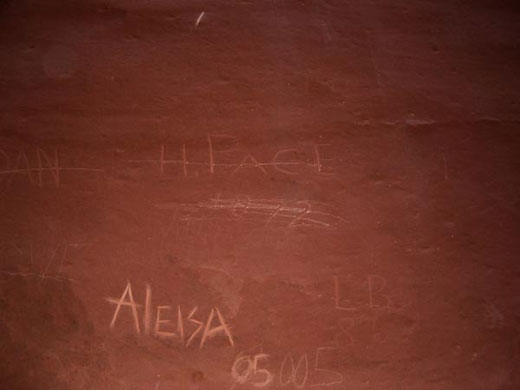Leprechaun\Archway Canyon
Vanishing History
Dave Pimental
I first saw the H. Pace 1872 inscription on February 15, 2006. At that time there were numerous other inscriptions on the wall. I took the photograph of the inscription nearly two months later on April 7, 2006.
Some time in 2008, persons unknown began an unauthorized clean–up project on their own initiative. It appeared as though they had been sanding the inscriptions from the wall with a battery–operated disc sander. A few large areas had been worked on, and the names had been scoured down as deep as necessary to obliterate the letters and dates. The Pace inscription had not yet been destroyed, and I hoped that the culprit had finished their job and would leave behind the more significant names.
From my observations, the inscriptions were visited by presumably the same party, and further sanding was accomplished on at least two occasions. On February 12, 2009, I descended the canyon and found that the Pace inscription had been removed—the entire wall had been sanded down. Only a few faint inscriptions remained.
This particular inscription is of note to me for a few reasons. It was the first inscription of any age that I had come across in my desert travels. Since he had seen the inscription panel, Brandt Hart and I discussed the name Pace and some others that were on the wall. He, Steve Allen, and Jim Knipmeyer pointed out several other old inscriptions in the North Wash area. That grabbed my interest and eventually led to a genuine passion for the history of the Colorado Plateau.
The H. Pace inscription is an early one for the North Wash area. There were a few men named Pace on the ‘Hole in the Rock’ or San Juan Mission of 1879, and the name Pace was prominent among the early settlers of the area that is now Capitol Reef National Park and Torrey. However, the date in North Wash is earlier than that.
The only party that I have found that were in that area at that time were members of John Wesley Powell’s expedition when they made their way from Kanab to the mouth of the Dirty Devil River to retrieve a boat cached earlier. In both A. H. Thompson’s and John K. Hillers’ diaries, which recount the 1872 expedition to the mouth of the Dirty Devil River, several names are recorded, but the name Pace is not among them.
So the H. Pace inscription remains a mystery.
It is certainly reasonable to suppose that a lone prospector made an unrecorded journey to North Wash in the early 1870s. Another possibility is that H. Pace left us a birthdate. This has been known to happen occasionally. Of course, there is always the possibility that the inscription is a ‘fake’ or, alternatively, is simply being misinterpreted. If one looks very closely at the photograph, it appears that there is a period or comma after the 1 in the date. The inscription could conceivably read; H. Pace 1. 8 72. There may even be a second period after the 8 but it is very hard to tell. Was the inscription very old, or does the date signify 1972? It would be nice to go back and see.
In any case, it has been removed from the wall and, authentic or not, it is unfortunate that it is no longer there so that the mystery might be solved or the unending questions could inspire others to become immersed in the history of the exploration of the red rock country.
Inscriptions
James H. Knipmeyer
Names and/or dates. Seemingly forever mankind has had an innate desire to leave his mark behind him for others to see, to visually, if not verbally, declare that “I was here!” In more modern times this practice has been looked upon as graffiti, a mar or blight upon the landscape. And in some instances this is undoubtedly true; a name carved or drawn across the face of a prehistoric pictograph or petroglyph panel, for example, or an unusually large and obvious rendering scrawled onto a canyon wall or cliffside.
However, in the majority of places within the region of the Colorado Plateau the geographic features are vast enough and the inscriptions small enough to be almost inconspicuous. Indeed, to those visitors with at least a working knowledge of the history of the canyon area, such names and dates are a veritable delight to happen upon. This is especially true of those prior to the mid–1900s, after which uranium prospectors began to swarm over the plateau land. From the 1600s on, explorers, priests, traders, trappers, scientists, miners, settlers, cattlemen, and simply travelers have left a sign of their passing on rock boulders and canyon walls. In many cases this may be the only ‘written’ record of that person and his incursion to that particular place. And as such that inscription is a part of history and must be treated so.
In the last decade or two the ever–growing environmental movement has made even Colorado Plateau hikers, backpackers, and slot canyoneers to be more aware of their surroundings. Unfortunately, this has also given rise in increasing instances to the eradication of what good–intentioned people see as graffiti. Therefore, they purposely try to obliterate what is to them seemingly offensive names and dates, regardless of age or possible historical significance. They attempt to rub out the letters and numerals, or simply scratch over them.
However, it is not all that easy to erase such carvings or drawings on the sandstone by the casual passerby. All too often, from a purely aesthetic viewpoint, the results are often much more displeasing to the eye than the original inscription. So, leave them alone, even the ‘modern’ ones. If an inscription is deemed advisable to be removed, leave it to someone with the necessary skill and know–how. Ultimately, just be sure to not add anything of your own!
© 2006 & 2009 Dave Pimental & James H. Knipmeyer

